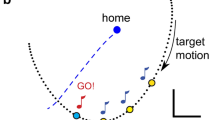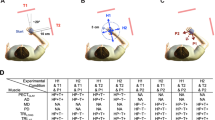Abstract
When lifting or moving a novel object, humans are routinely able to quickly characterize the nature of the unknown load and swiftly achieve the desired movement trajectory. It appears that both tactile and proprioceptive feedback systems help humans develop an accurate prediction of load properties and determine how associated limb segments behave during voluntary movements. While various types of limb movement information, such as position, velocity, acceleration, and manipulating forces, can be detected using human tactile and proprioceptive systems, we know little about how the central nervous system decodes these various types of movement data, and in which order or priority they are used when developing predictions of joint motion during novel object manipulation. In this study, we tested whether the ability to predict motion is different between position- (elastic), velocity- (viscous), and acceleration-dependent (inertial) loads imposed using a multiaxial haptic robot. Using this protocol, we can learn if the prediction of the motion model is optimized for one or more of these types of mechanical load. We examined ten neurologically intact subjects. Our key findings indicated that inertial and viscous loads showed the fastest adaptation speed, whereas elastic loads showed the slowest adaptation speed. Different speeds of adaptation were observed across different magnitudes of the load, suggesting that human capabilities for predicting joint motion and manipulating loads may vary systematically with different load types and load magnitudes. Our results imply that human capabilities for load manipulation seems to be most sensitive to and potentially optimized for inertial loads.








Similar content being viewed by others
Data availability
All data generated or analyzed during this study are included in this published article. The datasets during and/or analyzed during the current study are available from the corresponding author on reasonable request.
Code availability
Analysis of all data in this study was performed using the Matlab software and the code, which will be available on reasonable request.
References
Bock O (1990) Load compensation in human goal-directed arm movements. Behav Brain Res 41:167–177
Brindley G (1964) The use made by the cerebellum of the information that it receives from sense organs. Intern Brain Res Organ Bull 3:80
Cherpin A, Kager S, Budhota A et al (2019) A preliminary study on the relationship between proprioceptive deficits and motor functions in chronic stroke patients. 2019 IEEE 16th International Conference on Rehabilitation Robotics (ICORR). IEEE, pp 465–470
Cooke J, Diggles VA (1984) Rapid error correction during human arm movements: evidence for central monitoring. J Mot Behav 16:348–363
Cordo P, Carlton L, Bevan L, Carlton M, Kerr GK (1994) Proprioceptive coordination of movement sequences: role of velocity and position information. J Neurophysiol 71:1848–1861. https://doi.org/10.1152/jn.1994.71.5.1848
Crevecoeur F, Thonnard J-L, Lefevre P (2020) A very fast time scale of human motor adaptation: within movement adjustments of internal representations during reaching. eNeuro. https://doi.org/10.1523/ENEURO.0149-19.2019
Feldman AG (2016) Active sensing without efference copy: referent control of perception. J Neurophysiol 116:960–976
Feldman AG, Levin MF (2009) The equilibrium-point hypothesis–past, present and future. Progress in motor control. Springer, pp 699–726
Flanagan JR, Wing AM (1997) The role of internal models in motion planning and control: evidence from grip force adjustments during movements of hand-held loads. J Neurosci 17:1519–1528. https://doi.org/10.1007/s00221-008-1691-3
Flash T, Gurevich I (1997a) Arm trajectory generation and stiffness control during motor adaptation to external loads. Self-organization computational maps and motor control. Elsevier, pp 423–482
Flash T, Gurevich I (1997b) Models of motor adaptation and impedance control in human arm movements. Adv Psychol 119:423–481. https://doi.org/10.1016/S0166-4115(97)80015-5
Flash T, Hogan N (1985) The coordination of arm movements: an experimentally confirmed mathematical model. J Neurosci 5:1688–1703
Forssberg H, Eliasson A, Kinoshita H, Johansson R, Westling G (1991) Development of human precision grip I: basic coordination of force. Exp Brain Res 85:451–457
Forssberg H, Kinoshita H, Eliasson A, Johansson R, Westling G, Gordon A (1992) Development of human precision grip. Exp Brain Res 90:393–398
Gribble PL, Scott SH (2002) Overlap of internal models in motor cortex for mechanical loads during reaching. Nature 417:938
Gritsenko V, Krouchev NI, Kalaska JF (2007) Afferent input, efference copy, signal noise, and biases in perception of joint angle during active versus passive elbow movements. J Neurophysiol 98:1140–1154
Häger-Ross C, Cole KJ, Johansson RS (1996) Grip-force responses to unanticipated object loading: load direction reveals body-and gravity-referenced intrinsic task variables. Exp Brain Res 110:142–150
Huang FC, Patton JL (2011) Evaluation of negative viscosity as upper extremity training for stroke survivors. 2011 IEEE International Conference on Rehabilitation Robotics. IEEE, pp 1–6
Hwang EJ, Shadmehr R (2005) Internal models of limb dynamics and the encoding of limb state. J Neural Eng 2:S266
Hwang EJ, Donchin O, Smith MA, Shadmehr R (2003) A gain-field encoding of limb position and velocity in the internal model of arm dynamics. PLoS Biol 1:e25
Hwang EJ, Smith MA, Shadmehr R (2006) Adaptation and generalization in acceleration-dependent force fields. Exp Brain Res 169:496–506
Johansson RS, Westling G (1984) Roles of glabrous skin receptors and sensorimotor memory in automatic control of precision grip when lifting rougher or more slippery objects. Exp Brain Res 56:550–564
Johansson R, Westling G (1988) Coordinated isometric muscle commands adequately and erroneously programmed for the weight during lifting task with precision grip. Exp Brain Res 71:59–71
Johansson RS, Häger C, Riso R (1992) Somatosensory control of precision grip during unpredictable pulling loads. Exp Brain Res 89:192–203
Kawato M (1999) Internal models for motor control and trajectory planning. Curr Opin Neurobiol 9:718–727
Linde RVD, Lammertse P, Frederiksen EB (2002) The HapticMaster, a new high-performance haptic interface. Proc. EuroHaptic, Edinburgh
Lipták BG (2018) Instrument engineers handbook volume two: process control and optimization. CRC Press
Matthews P (1982) Where does Sherrington’s” muscular sense” originate? Muscles, joints, corollary discharges? Annu Rev Neurosci 5:189–218
McIntyre J, Zago M, Berthoz A, Lacquaniti F (2001) Does the brain model Newton’s laws? Nat Neurosci 4:693
Milner TE, Franklin DW (2005) Impedance control and internal model use during the initial stage of adaptation to novel dynamics in humans. J Physiol 567:651–664. https://doi.org/10.1113/jphysiol.2005.090449
Nowak DA, Hermsdörfer J, Topka H (2003) Deficits of predictive grip force control during object manipulation in acute stroke. J Neurol 250:850–860
Pilon J-F, De Serres SJ, Feldman AG (2007) Threshold position control of arm movement with anticipatory increase in grip force. Exp Brain Res 181:49–67
Sherrington C (1906) The integrative action of the nervous system. C. Scribner’s sons, New York
Silva PS, Pereira P, Monteiro P, Silva PA, Vaz R (2013) Learning curve and complications of minimally invasive transforaminal lumbar interbody fusion. Neurosurg Focus 35:E7
Sokolov AA, Miall RC, Ivry RB (2017) The cerebellum: adaptive prediction for movement and cognition. Trends in Cogn Sci 21:313–332. https://doi.org/10.1016/j.tics.2017.02.005
Stoeckmann TM, Sullivan KJ, Scheidt RA (2009) Elastic, viscous, and mass load effects on poststroke muscle recruitment and co-contraction during reaching: a pilot study. Phys Ther 89:665–678. https://doi.org/10.2522/ptj.20080128
Tomi N, Gouko M, Ito K (2008) Impedance control complements imcomplete internal models under complex external dynamics. 2008 30th Annual International Conference of the IEEE Engineering in Medicine and Biology Society. IEEE, pp 5354–5357
Tseng Y-w, Diedrichsen Jr, Krakauer JW, Shadmehr R, Bastian AJ (2007) Sensory prediction errors drive cerebellum-dependent adaptation of reaching. J neurophysiol 98:54–62
Uno Y, Kawato M, Suzuki R (1989) Formation and control of optimal trajectory in human multijoint arm movement. Biol Cybern 61:89–101. https://doi.org/10.1007/BF00204593
Van Der Linde RQ, Lammertse P (2003) HapticMaster-a generic force controlled robot for human interaction. Ind Robot 30:515–524. https://doi.org/10.1108/01439910310506783
Vato A, Szymanski FD, Semprini M, Mussa-Ivaldi FA, Panzeri S (2014) A bidirectional brain-machine interface algorithm that approximates arbitrary force-fields. PLoS ONE. https://doi.org/10.1371/journal.pone.0091677
Vidoni ED, Boyd LA (2009) Preserved motor learning after stroke is related to the degree of proprioceptive deficit. Behav Brain Funct 5:1–10
Westling G, Johansson R (1984) Factors influencing the force control during precision grip. Exp Brain Res 53:277–284
Wolpert DM, Miall RC, Kawato M (1998) Internal models in the cerebellum. Trends Cogn Sci 2:338–347. https://doi.org/10.1016/S1364-6613(98)01221-2
Zhang L-Q, Son J, Park H-S, Kang SH, Lee Y, Ren Y (2017) Changes of shoulder, elbow, and wrist stiffness matrix post stroke. IEEE Trans Neural Syst Rehabil Eng 25:844–851
Acknowledgements
This project was supported under grant 90RES5013 from the U.S. Department of Health and Human Services, Administration on Community Living, National Institute on Disability, Independent Living and Rehabilitation Research. This work was also supported by the Korea Institute of Science and Technology (KIST) Institutional Program (Project no. 2E31110).
Funding
This project was supported under grant 90RES5013 from the U.S. Department of Health and Human Services, Administration on Community Living, National Institute on Disability, Independent Living and Rehabilitation Research. This work was also supported by the Korea Institute of Science and Technology (KIST) Institutional Program (Project no. 2E31110).
Author information
Authors and Affiliations
Contributions
All authors were heavily involved in study design, developing experimental apparatus, conducting an experiment, analyzing data, and writing the manuscript. KO carried out the experiments, performed statistical analysis, and drafted the manuscript. WZR designed the study and helped to write the manuscript. JC developed the experimental apparatus, helped to analyze the data, and finalized the manuscript. All the authors read and approved the final manuscript.
Corresponding author
Ethics declarations
Conflict of interest
There are no conflicts of interest to declare.
Ethical approval
All subjects signed an informed consent form which was approved by the Northwestern University Institutional Review Board (IRB) before the experiments. This information was also described in the methods section.
Consent for participate
All subjects signed an informed consent form, which was approved by the Northwestern University Institutional Review Board (IRB) before the experiments.
Consent for publication
All images, including subjects, were de-identified and added to this manuscript with subjects’ consent.
Additional information
Communicated by Bill J Yates.
Publisher's Note
Springer Nature remains neutral with regard to jurisdictional claims in published maps and institutional affiliations.
Rights and permissions
About this article
Cite this article
Oh, K., Rymer, W.Z. & Choi, J. The speed of adaptation is dependent on the load type during target reaching by intact human subjects. Exp Brain Res 239, 3091–3104 (2021). https://doi.org/10.1007/s00221-021-06189-3
Received:
Accepted:
Published:
Issue Date:
DOI: https://doi.org/10.1007/s00221-021-06189-3




